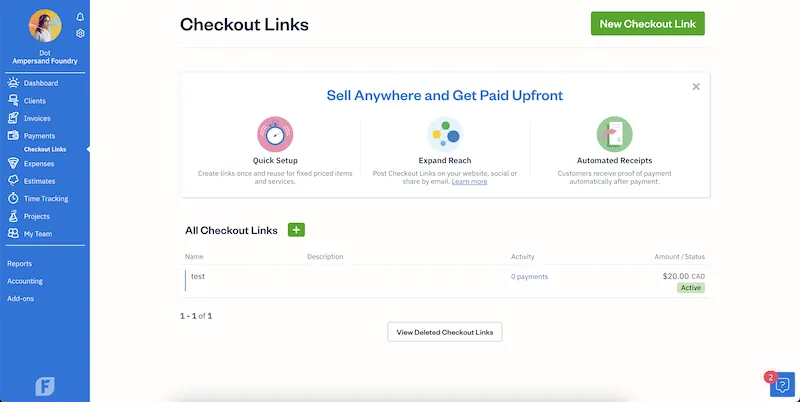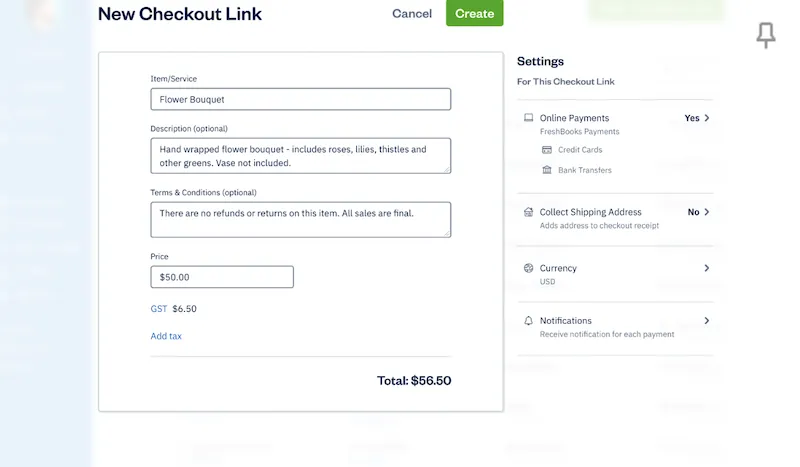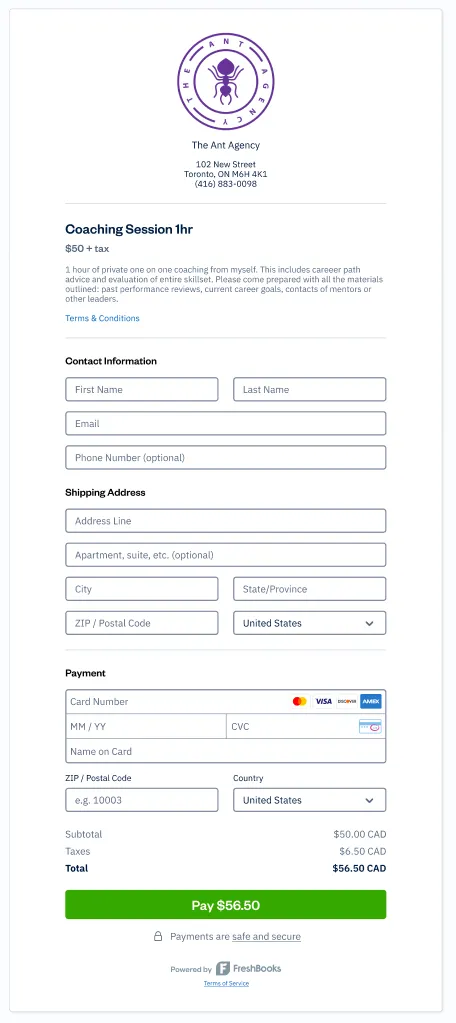Accept payments for products and services using a payment link - without having to create invoices.

Getting paid is something to celebrate. It means someone loved your product or service enough to hand over their hard-earned money for it.
And when it comes to getting paid, both you and your clients want transactions in as few steps as possible. When working on big projects spanning a few weeks the traditional process of creating invoices, sending them to clients, and accepting payment fits the bill. That doesn’t mean it’s one-size-fits-all. Collecting payment for a single item like an initial consultation or an event ticket doesn’t necessarily need to be invoiced, and can be done much quicker without having to invoice.
Enter a really simple, invoice-free, way to accept client payments online: A new one-off payment solution called Checkout Links. Now, you can create payment links, post them anywhere online—as a URL, text, or button link—and accept payments online without having to create an invoice.
What Are Checkout Links?
Checkout Links, or payment links, are an amazing new way to get paid in FreshBooks. They let your customers pay in a single click with bank transfers or credit cards. Post them anywhere you want to accept payments like a website, blog, or social channels. You can create an unlimited number of Checkout Links to be reused indefinitely or deactivated when you’re done with them.
What Can I Use Checkout Links For?
Checkout Links are designed to help you quickly collect payment for fixed-price items, whereas invoices are a record of work against a project or highlight the details of services rendered. They allow you to create custom payment links that can be used for as long as you want them – and avoid the need to collect copious amounts of payment details or invoice data. Overall, how you use payment links really depends on your business, but here’s a hit list of possibilities vs what might be commonly invoiced:
Checkout Links |
Invoicing |
|
|
Where Can I Find Checkout Links?
You can find a dedicated page for Checkout Links nestled in the main navigation under Payments (aka your payment page). Which means, Payments is now its own category in the main navigation, and within it are tabs for Invoice Payments, Other Income, and now Checkout Links Payments.
How Do I Create Checkout Links?
- Log into your FreshBooks account
- From your dashboard click Payments in the main navigation and then click Checkout Links when it appears underneath
- On the Checkout Links page click on the New Checkout Link button
- Fill out all fields that apply – don’t forget about the setting on right for Online Payments and Notifications
- Click Done to apply the payment settings
-
That’s it! Just click the Create button to make your new Checkout Link (which will generate a unique, secure payment link)
- A pop-up will appear with the link – click Copy to Clipboard and then Done. Now you can paste it anywhere you want to accept payment.
What Do My Clients See?
When a Checkout Link is clicked, your customer is presented with a payment page/box asking them to fill out all the pertinent payment information and their contact information (including shipping address if you want to request it). They have the option to pay with a credit card or bank transfer. Then, all they have to do is click. A receipt is automatically generated on a checkout page right after they submit payment.
What Payment Gateways Are Available With These Payment Links?
Your customers can pay by either credit card or bank transfer, which means you can choose to accept through FreshBooks Payments and Stripe. Each payment provider then gives you other payment methods/options including Visa, Mastercard, Discover, AMEX, Apple Pay, and so on. Which allows your customers to use payment links with their preferred payment methods.
How Else Do Checkout Links Help With Clients?
When a new client of yours pays by Checkout Link, they’ll automatically be added as a Client within your FreshBooks account. This makes it easier to track and manage every payment you receive, and means less time spent adding new client profiles every time you get paid. It’s a simple, barrier-free payment process that allows you to sell products and collect payments super fast.
Where Are These Transactions Reflected in My Reporting?
You’ll see all the financial information for Checkout Link transactions reflected under Sales > Other Income in the Profit & Loss Report. This number doesn’t include the tax, which is available separately in the Sales Tax Summary Report.
FreshBooks Is Always Here to Help
Payment links are an exciting function we hope you find helpful. But if you have any questions, or you just need a hand getting started, a team is ready to help you out. Contact them here.
Click here to create your first link or here for a detailed FAQ.
This post was last updated on December 14, 2022.

Written by Daniel Reiter, Former Editor-in-Chief, FreshBooks
Posted on December 14, 2022









